Concrete Defects Sizing by Means of Ultrasonic Velocity Maps
Abstract
1. Introduction
- maintenance of the integrity of the structural element or the building with negligible interference with its current condition;
- acquisition of data on areas of the structural element or the building otherwise inaccessible;
- possibility to study the structure even when advanced instability phenomena or precarious structural situations are present, with sufficient margins of safety for the operators;
- possibility of investigation either on individual elements or on the entire body of the structure, or at least on considerable parts thereof; this is impossible to the traditional invasive tests, as core extraction, which, being forcibly confined to single points, do not provide information generalizable to the whole complex;
- consideration of the current boundary and operating conditions of the work, to the advantage of the reliability of information: the exclusive use of tests on laboratory samples, almost never really undisturbed, involves the use of corrective coefficients never so refined as to summarize the real conditions;
- rapidity of execution;
- repeatability of the tests; and
- economy in materials and test equipment.
- surface hardness methods: pull-out, rebound hammer, flat jacks;
- acoustical and vibrational methods: dynamic characterization, sonic and ultrasonic techniques, acoustic emission;
- electrical and magnetic methods: electrical resistivity, potential field methods, radar, infrared thermography, microwave testing, magnetic flux leakage;
- radiological methods: X-rays, gamma rays, neutron beams; and
- visual and optical methods: endoscopy, interferometry, holography, laser, dye penetrants.
2. Ultrasonic Testing
3. Experimental Tests
- a pair of standard transducers (diameter 0.04 m) with natural frequency of 54 kHz for emitting and receiving signals;
- a unit for signals generation, acquisition and preliminary analysis;
- a PC for data storage and further signal processing; and
- a dedicated software, Pundit Link, which unlocks the full capabilities of the ultrasonic test system.
4. Data Processing and Results
4.1. Velocity Maps
4.1.1. Velocity Maps. Type 1
4.1.2. Velocity Maps. Type 2
5. Defect Sizing
6. Comments
- small defects are more difficult to identify but are also generally less important from an engineering point of view;
- more refined measurements grids are more sensitive to the presence of defects, but at the same time they are strongly affected by the intrinsic irregularity of the material, which influences the propagation of the signal and, thus, its velocity;
- when the goal is a qualitative preliminary diagnosis of the concrete element or structure, less refined grids are already sufficient and facilitate both the execution of the tests and the data analysis; and
- the timing and costs of the tests cannot be ignored.
7. Conclusions
- The five measurements grids show similar value of Vmax and Vmean and a slight difference in Vmin, which is the most scattered property accordingly to the fact that defects slow down the velocity of the signals that are diffracted around the periphery of the defect, whereas highest values of V are generally reached in points without defects regardless of the presence or not of some defects in other areas of the wall. This finding confirms the sensitivity of V to the presence of anomalies inside the concrete.
- The velocity maps of type 1, based on the definition of various V levels, allow to collect information on the inside of the wall and to identify the presence of areas characterized by anomalous V distribution, thus, giving a valuable picture of the wall. Nevertheless, an accurate sizing of the artificial defects is difficult because signals propagation is affected not only by the artificial defects but also by all changes of the inner structure of the wall.
- The velocity maps of type 2 have been implemented in order to highlight only the artificial defects, even if at the price of losing some information, and have been used to define a criterion for evaluating the accuracy of V maps in sizing the artificial defects based on an index I that takes into account the sum Aest of the area of dark cells highlighted by the map and the actual area of the defect Aact.
- The choice of the measurements grid significantly influences the diagnostic capacity of UT. The proportion between the grid pitch and the size of the defect, along with the misalignment between the center of the grid cell and the position of the defect, are the most influencing factors. It has been pointed out that as the grid spacing exceeds the size of the defect, the error made by UT in estimating the size of the defect increases significantly and that the unfavorable combination of cells size and eccentricity between the cells center and the defect itself could lead to very large miscalculating in defect sizing.
Author Contributions
Funding
Conflicts of Interest
References
- Boosting Building Renovation: What Potential and Value for Europe? Directorate General for Internal Policies Policy Department A: Economic and Scientific Policy. Available online: http://www.europarl.europa.eu/RegData/etudes/STUD/2016/587326/IPOL_STU(2016)587326_EN.pdf (accessed on 19 November 2018).
- CRESME Technical Report. 2017. Available online: http://www.cresme.it/doc/rapporti/rapporto-cresme-symbola-2017.pdf (accessed on 19 november 2018).
- Frangopol, D.M.; Liu, M. Maintenance and management of civil infrastructure based on condition, safety, optimization, and life-cycle cost. Struct. Infrastruct. Eng. 2007, 3, 29–41. [Google Scholar] [CrossRef]
- Frangopol, D.M.; Saydam, D.; Kim, S. Maintenance, management, life-cycle design and performance of structures and infrastructures: A brief review. Struct. Infrastruct. Eng. 2012, 8, 1–25. [Google Scholar] [CrossRef]
- Jensen, P.A.; Maslesa, E. Value based building renovation—A tool for decision making. Build. Environ. 2015, 92, 1–9. [Google Scholar] [CrossRef]
- Fib Bulletin N° 22. Monitoring and Safety Evaluation of Existing Concrete Structures; State-of-Art Report; fib: Lausanne, Switzerland, May 2003. [Google Scholar]
- Fib Bulletin N° 17. Management, Maintenance and Strengthening of Concrete Structures; Technical Report; fib: Lausanne, Switzerland, April 2002. [Google Scholar]
- McCann, D.M.; Forde, M.C. Review of NDT methods in the assessment of concrete and masonry structures. Ndt E Int. 2001, 34, 71–84. [Google Scholar] [CrossRef]
- Hussain, A.; Akhtar, S. Review of non-destructive tests for evaluation of historic masonry and concrete structures. Arab. J. Sci. Eng. 2017, 42, 925–940. [Google Scholar] [CrossRef]
- Moropoulou, A.; Labropoulos, K.C.; Delegou, E.T.; Karoglou, M.; Bakolas, A. Non-destructive techniques as a tool for the protection of built cultural heritage. Constr. Build. Mater. 2013, 48, 1222–1239. [Google Scholar] [CrossRef]
- Concu, G.; Nicolo, B.D.; Pani, L. Non-destructive testing as a tool in reinforced concrete buildings refurbishments. Struct. Surv. 2011, 29, 147–161. [Google Scholar] [CrossRef]
- Rehman, S.K.U.; Ibrahim, Z.; Memon, S.A.; Jameel, M. Nondestructive test methods for concrete bridges: A review. Constr. Build. Mater. 2016, 107, 58–86. [Google Scholar] [CrossRef]
- Blitz, J. Electrical and Magnetic Methods of Non-Destructive Testing, 2nd ed.; Springer Science & Business Media: Dordrecht, The Netherlands, 1997; ISBN 9789401158183. [Google Scholar]
- Maierhofer, C.; Reinhardt, H.W.; Dobmann, G. Non-Destructive Evaluation of Reinforced Concrete Structures: Non-Destructive Testing Methods; Woodhead Publishing: Cambridge, UK, 2010; ISBN 9781845699604. [Google Scholar]
- Popovics, J.S. Ultrasonic testing of concrete structures. Mater. Eval. 2005, 63, 50–55. [Google Scholar]
- De Nicolo, B.; Piga, C.; Popescu, V.; Concu, G. Non-Invasive Acoustic Measurements for Faults Detecting in Building Materials and Structures. In Applied Measurement Systems; Haq, Z., Ed.; InTech: Rijeka, Croatia, 2012; ISBN 978-953-51-0103-1. [Google Scholar]
- Krause, M.; Mielentz, F.; Milman, B.; Müller, W.; Schmitz, V.; Wiggenhauser, H. Ultrasonic imaging of concrete members using an array system. Ndt E Int. 2001, 34, 403–408. [Google Scholar] [CrossRef]
- Schickert, M.; Krause, M.; Müller, W. Ultrasonic imaging of concrete elements using reconstruction by synthetic aperture focusing technique. J. Mater. Civ. Eng. 2003, 15, 235–246. [Google Scholar] [CrossRef]
- De Nicolo, B.; Mistretta, F.; Concu, G. NDT ultrasonic evaluation of early compressive strength in SCC. In Proceedings of the 9th International Conference on Inspection, Appraisal, Repairs and Maintenance of Structures, Fuzhou, China, 20–21 October 2005; pp. 187–194, ISBN 981-05-3548-1. [Google Scholar]
- Del Río, L.M.; Jiménez, A.; López, F.; Rosa, F.J.; Rufo, M.M.; Paniagua, J.M. Characterization and hardening of concrete with ultrasonic testing. Ultrasonics 2004, 42, 527–530. [Google Scholar] [CrossRef] [PubMed]
- Trtnik, G.; Gams, M. Ultrasonic assessment of initial compressive strength gain of cement based materials. Cem. Concr. Res. 2015, 67, 148–155. [Google Scholar] [CrossRef]
- Trtnik, G.; Gams, M. Recent advances of ultrasonic testing of cement based materials at early ages. Ultrasonics 2014, 54, 66–75. [Google Scholar] [CrossRef] [PubMed]
- Concu, G.; De Nicolo, B.; Mistretta, F.; Pani, L. Ultrasonic test methods for assessment of concrete strength during construction. In Proceedings of the 10th International Conference on Inspection, Appraisal, Repairs and Maintenance of Structures, Hong Kong, China, 25–26 October 2006; pp. 83–88, ISBN 981-05-5562-8. [Google Scholar]
- Popovics, J.S.; Subramaniam, K.V. Review of ultrasonic wave reflection applied to early-age concrete and cementitious materials. J. Nondestruct. Eval. 2015, 34, 267. [Google Scholar] [CrossRef]
- Haach, V.G.; Juliani, L.M.; Roz, M.R.D. Ultrasonic evaluation of mechanical properties of concretes produced with high early strength cement. Constr. Build. Mater. 2015, 96, 1–10. [Google Scholar] [CrossRef]
- Zhao, Y.; Hao, W.; Xu, X. Experimental study of the working stress state of concrete frame structures through ultrasonic testing. Chem. Eng. Trans. 2017, 62, 919–924. [Google Scholar]
- Ivanchev, I. Experimental determination of concrete compressive strength by non-destructive ultrasonic pulse velocity method. Int. J. Res. Appl. Sci. Eng. Technol. 2018, 6. [Google Scholar] [CrossRef]
- Nogueira, C.L.; Willam, K.J. Ultrasonic testing of damage in concrete under uniaxial compression. Mater. J. 2001, 98, 265–275. [Google Scholar]
- Abo-Qudais, S.A. Effect of concrete mixing parameters on propagation of ultrasonic waves. Constr. Build. Mater. 2005, 19, 257–263. [Google Scholar] [CrossRef]
- Kewalramani, M.A.; Gupta, R. Concrete compressive strength prediction using ultrasonic pulse velocity through artificial neural networks. Autom. Constr. 2006, 15, 374–379. [Google Scholar] [CrossRef]
- Concu, G.; De Nicolo, B.; Trulli, N.; Valdes, M. Estimation of concrete strength and stiffness by means of ultrasonic testing. In Concrete Repair, Rehabilitation and Retrofitting IV; Dehn, F., Beushausen, H.-D., Alexander, M.G., Moyo, P., Eds.; Taylor & Francis Group: London, UK, 2016; ISBN 978-113802843-2. [Google Scholar]
- Hernández, M.G.; Izquierdo, M.A.G.; Ibáñez, A.; Anaya, J.J.; Ullate, L.G. Porosity estimation of concrete by ultrasonic NDE. Ultrasonics 2000, 38, 531–533. [Google Scholar] [CrossRef]
- Benmeddour, F.; Villain, G.; Abraham, O.; Choinska, M. Development of an ultrasonic experimental device to characterise concrete for structural repair. Constr. Build. Mater. 2012, 37, 934–942. [Google Scholar] [CrossRef]
- Moradi, F.; Rivard, P.; Lamarche, C.P.; Kodjo, S.A. Evaluating the damage in reinforced concrete slabs under bending test with the energy of ultrasonic waves. Constr. Build. Mater. 2014, 73, 663–673. [Google Scholar] [CrossRef]
- Molero, M.; Aparicio, S.; Al-Assadi, G.; Casati, M.J.; Hernández, M.G.; Anaya, J.J. Evaluation of freeze–thaw damage in concrete by ultrasonic imaging. Ndt E Int. 2012, 52, 86–94. [Google Scholar] [CrossRef]
- Toutanji, H. Ultrasonic wave velocity signal interpretation of simulated concrete bridge decks. Mater. Struct. 2000, 33, 207–215. [Google Scholar] [CrossRef]
- Shah, A.A.; Ribakov, Y. Non-linear ultrasonic evaluation of damaged concrete based on higher order harmonic generation. Mater. Des. 2009, 30, 4095–4102. [Google Scholar] [CrossRef]
- Antonaci, P.; Bruno, C.L.E.; Gliozzi, A.S.; Scalerandi, M. Monitoring evolution of compressive damage in concrete with linear and nonlinear ultrasonic methods. Cem. Concr. Res. 2010, 40, 1106–1113. [Google Scholar] [CrossRef]
- Antonaci, P.; Bruno, C.L.E.; Bocca, P.G.; Scalerandi, M.; Gliozzi, A.S. Nonlinear ultrasonic evaluation of load effects on discontinuities in concrete. Cem. Concr. Res. 2010, 40, 340–346. [Google Scholar] [CrossRef]
- Rucka, M.; Wilde, K. Experimental study on ultrasonic monitoring of splitting failure in reinforced concrete. J. Nondestruct. Eval. 2013, 32, 372–383. [Google Scholar] [CrossRef]
- Adamatti, D.S.; Lorenzi, A.; Chies, J.A.; Silva Filho, L.C.P. Analysis of reinforced concrete structures through the ultrasonic pulse velocity: Technological parameters involved. Rev. IBRACON Estrut. Mater. 2017, 10, 358–385. [Google Scholar] [CrossRef]
- Concu, G.; De Nicolo, B.; Trulli, N.; Valdes, M. Transducers frequency influence on ultrasonic velocity measurements in concrete specimens. In Research and Applications in Structural Engineering, Mechanics and Computation; Taylor & Francis Group: London, UK, 2013; ISBN 9781138000612. [Google Scholar]
- Lorenzi, A.; Caetano, L.F.; Chies, J.A.; Pinto da Silva Filho, L.C. Investigation of the potential for evaluation of concrete flaws using nondestructive testing methods. ISRN Civ. Eng. 2014, 2014, 543090. [Google Scholar] [CrossRef]
- EN 12504-4. Testing Concrete—Part 4: Determination of Ultrasonic Pulse Velocity; British Standards Institution: London, UK, 2004. [Google Scholar]
- Guidelines for the Evaluation of Concrete Characteristics On-Site. High Council for Public Works—Central Technical, Service, 2017. Available online: http://cslp.mit.gov.it/index.php?option=com_content&task=view&id=157&Itemid=20 (accessed on 19 November 2018).
- Krautkramer, J.; Krautkramer, H. Ultrasonic Testing of Materials; Springer-Verlag Berlin Heidelberg GmbH: Berlin/Heidelberg, Germany, 1990. [Google Scholar]
- Berke, M. Non-destructive material testing with ultrasonics. Introduction to the basic principles. NDT.net 2000, 5, 9. [Google Scholar]
- Mahure, N.V.; Vijh, G.K.; Sharma, P.; Sivakumar, N.; Ratnam, M. Correlation between pulse velocity and compressive strength of concrete. Int. J. Earth Sci. Eng. 2011, 4, 871–874. [Google Scholar]
- Bogas, J.A.; Gomes, M.G.; Gomes, A. Compressive strength evaluation of structural lightweight concrete by non-destructive ultrasonic pulse velocity method. Ultrasonics 2013, 53, 962–972. [Google Scholar] [CrossRef]
- Demirboga, R.; Türkmen, İ.; Karakoç, M.B. Relationship between ultrasonic velocity and compressive strength for high-volume mineral-admixtured concrete. Cem. Concr. Res. 2004, 34, 2329–2336. [Google Scholar] [CrossRef]
- Lafhaj, Z.; Goueygou, M.; Djerbi, A.; Kaczmarek, M. Correlation between porosity, permeability and ultrasonic parameters of mortar with variable water/cement ratio and water content. Cem. Concr. Res. 2006, 36, 625–633. [Google Scholar] [CrossRef]
- Taffe, A.; Mayerhofer, C. Guidelines for NDT methods in civil engineering. In Proceedings of the 5th International Symposium on NDT in Civil Engineering, Berlin, Germany, 16–19 September 2003; German Society for Non-Destructive Testing: Berlin, Germany, 2003. ISBN 3-931381-49-8. [Google Scholar]
- Neville, A.M.; Brooks, J.J. Concrete Technology, 6th ed.; Longman Singapor Publishers Pte: Singapore, 1997. [Google Scholar]
- Macdonald, S. Concrete: Building Pathology; John Wiley & Sons: Hoboken, NJ, USA, 2008; ISBN 9781405147538. [Google Scholar]
- Sezer Atamturktur, H. Detection of Internal Defects in Concrete Members Using Global Vibration Characteristics. ACI Mater. J. 2013, 110, 1. [Google Scholar]
- Santos, J. Common pathologies in RC bridge structures: A statistical analysis. Electron. J. Struct. Eng. 2007, 7, 19–26. [Google Scholar]
- Garrido Vazquez, E.; Naked Haddad, A.; Linhares Qualharini, E.; Amaral Alves, L.; Amorim Féo, I. Pathologies in Reinforced Concrete Structures. In Sustainable Constructions Building Performance Simulation and Asset and Maintenance Management; Delgado, J.M.P.Q., Ed.; Springer: Singapore, 2016; ISBN 978-981-10-0650-0, 978-981-10-0651-7. [Google Scholar]
- Cheng, C.C.; Cheng, T.M.; Chiang, C.H. Defect detection of concrete structures using both infrared thermography and elastic waves. Autom. Constr. 2008, 18, 87–92. [Google Scholar] [CrossRef]
- Haach, V.G.; Ramirez, F.C. Qualitative assessment of concrete by ultrasound tomography. Constr. Build. Mater. 2016, 119, 61–70. [Google Scholar] [CrossRef]
- Maierhofer, C.; Brink, A.; Röllig, M.; Wiggenhauser, H. Detection of shallow voids in concrete structures with impulse thermography and radar. Ndt E Int. 2003, 36, 257–263. [Google Scholar] [CrossRef]
- Cotič, P.; Kolarič, D.; Bosiljkov, V.B.; Bosiljkov, V.; Jagličić, Z. Determination of the applicability and limits of void and delamination detection in concrete structures using infrared thermography. Ndt E Int. 2015, 74, 87–93. [Google Scholar] [CrossRef]
- Cotič, P.; Jagličić, Z.; Niederleithinger, E.; Stoppel, M.; Bosiljkov, V. Image fusion for improved detection of near-surface defects in ndt-ce using unsupervised clustering methods. J. Nondestruct. Eval. 2014, 33, 384–397. [Google Scholar] [CrossRef]
- Shin, S.W.; Oh, T.; Popovics, J.S. Identification of Delamination Damages in Concrete Structures Using Impact Response of Delaminated Concrete Section. In Proceedings of the 2013 World Congress on Advances in Structural Engineering and Mechanics, Jeiu, Korea, 8–12 September 2013; Techno-Press: Daejeon, Korea, 2013. [Google Scholar]
- Van der Wielen, A.; Courard, L.; Nguyen, F. Nondestructive Detection of Delaminations in Concrete Bridge Decks. In Proceedings of the XIII International Conference on Ground Penetrating Radar, Lecce, Italy, 21–25 June 2010; Institute of Electrical and Electronics Engineers (IEEE): Piscataway, NJ, USA, 2010. ISBN 9781424446049. [Google Scholar]
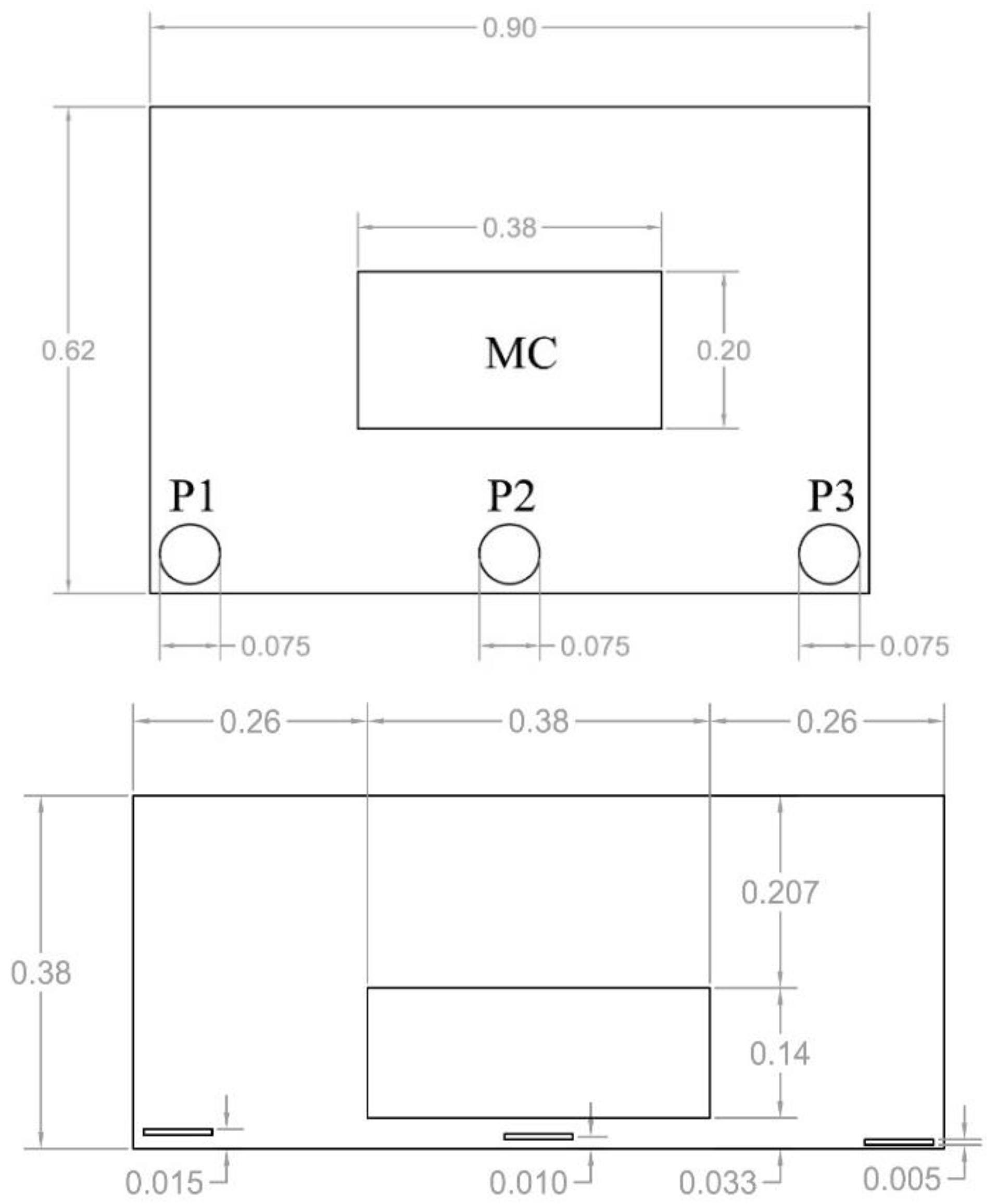
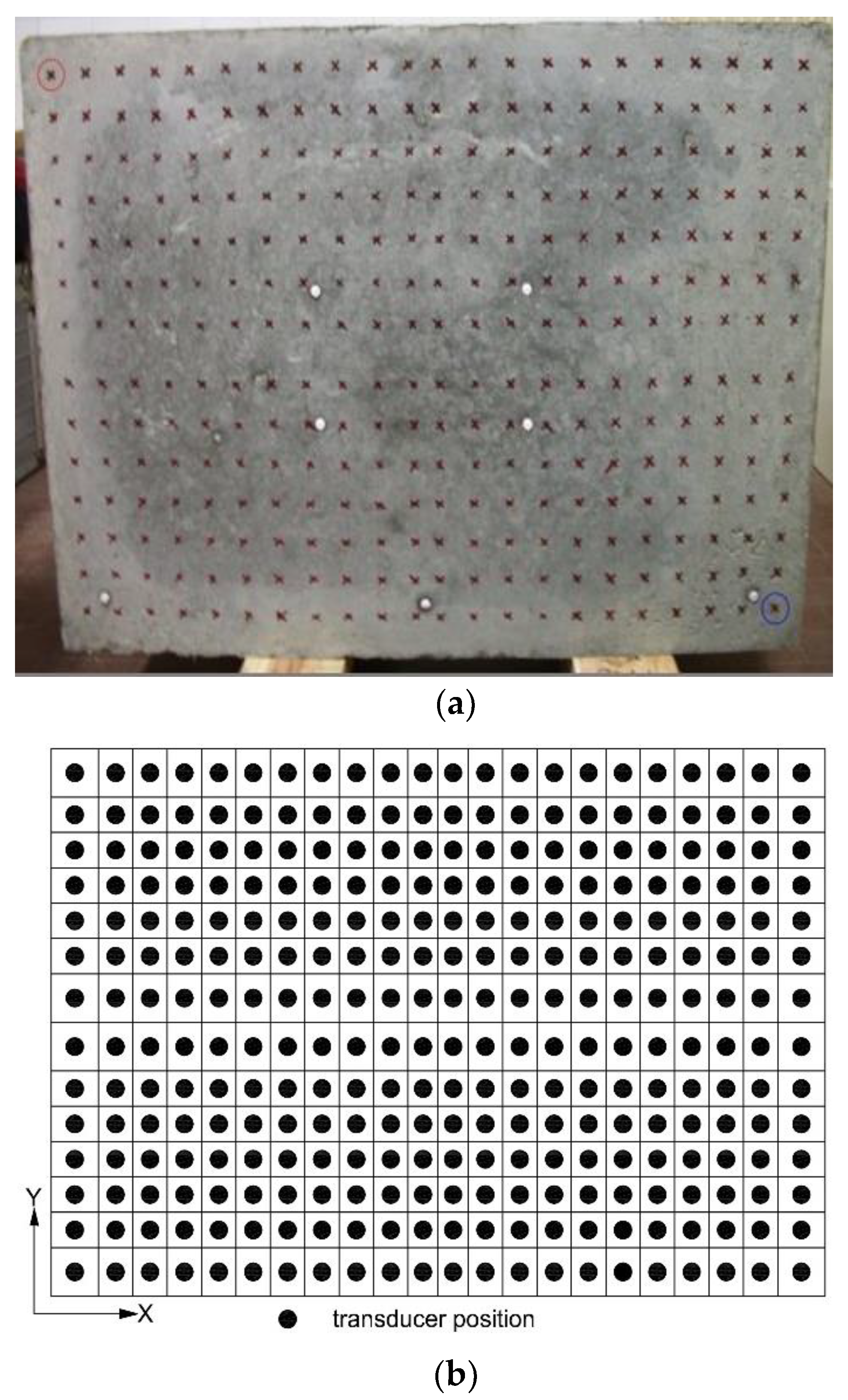
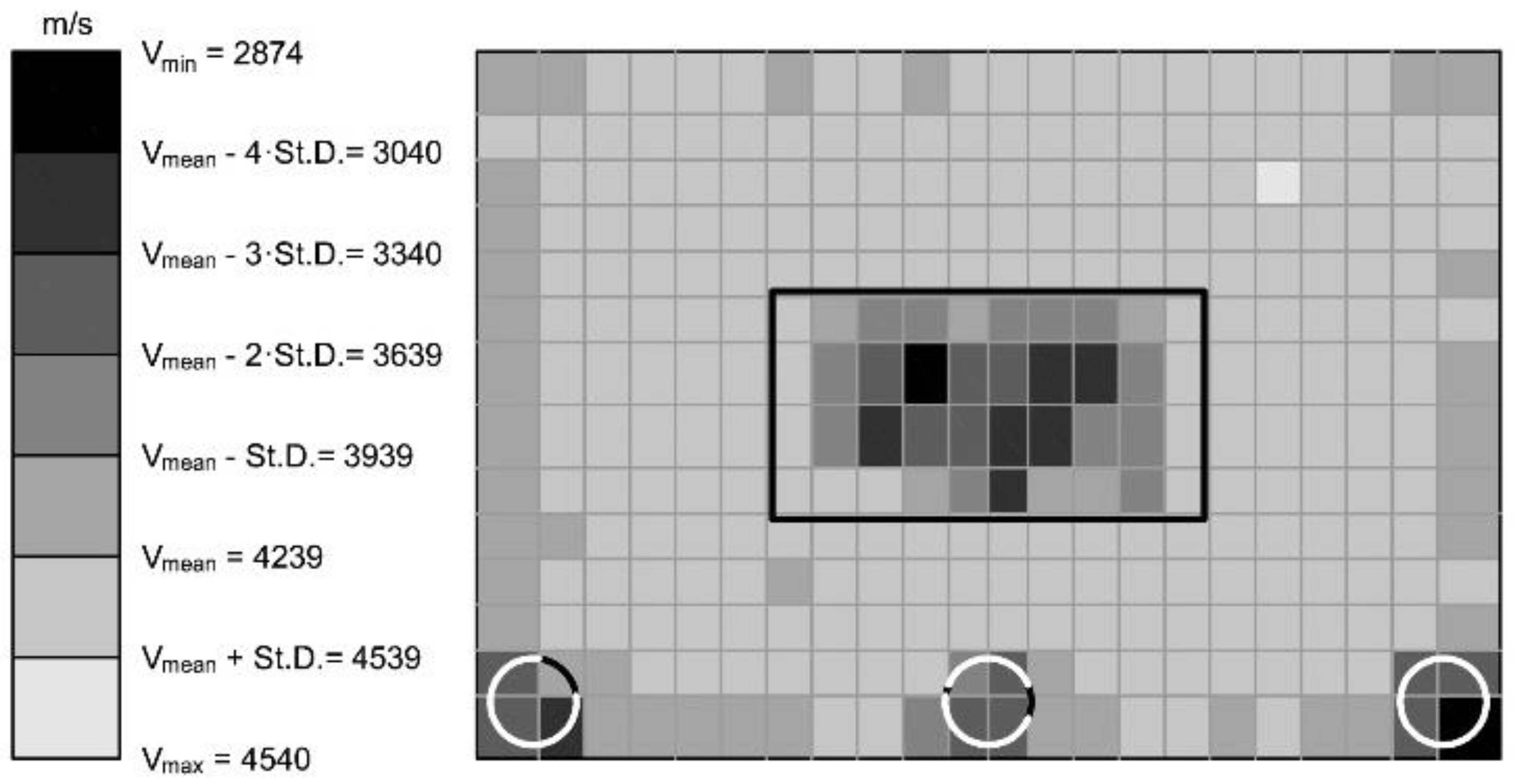
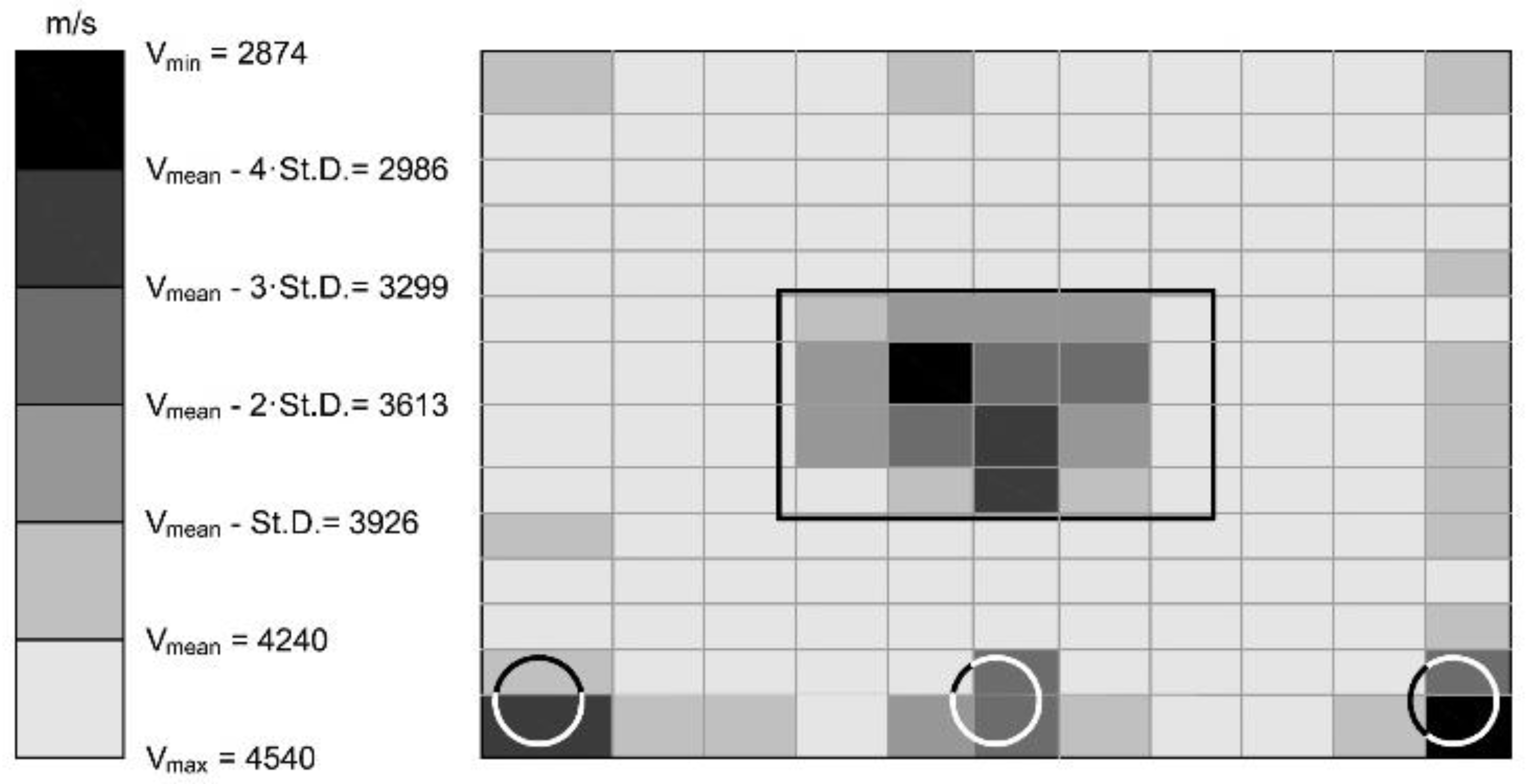
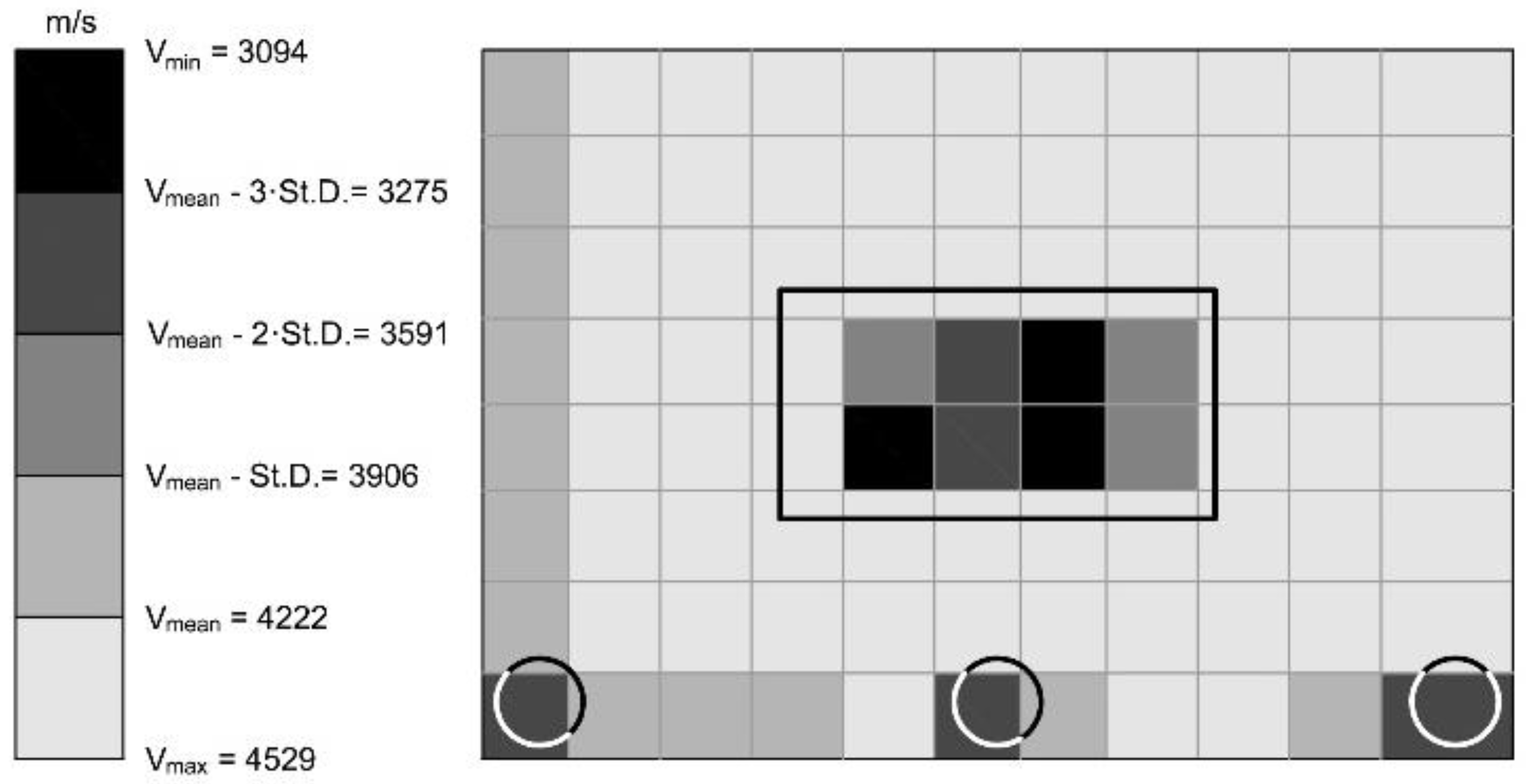

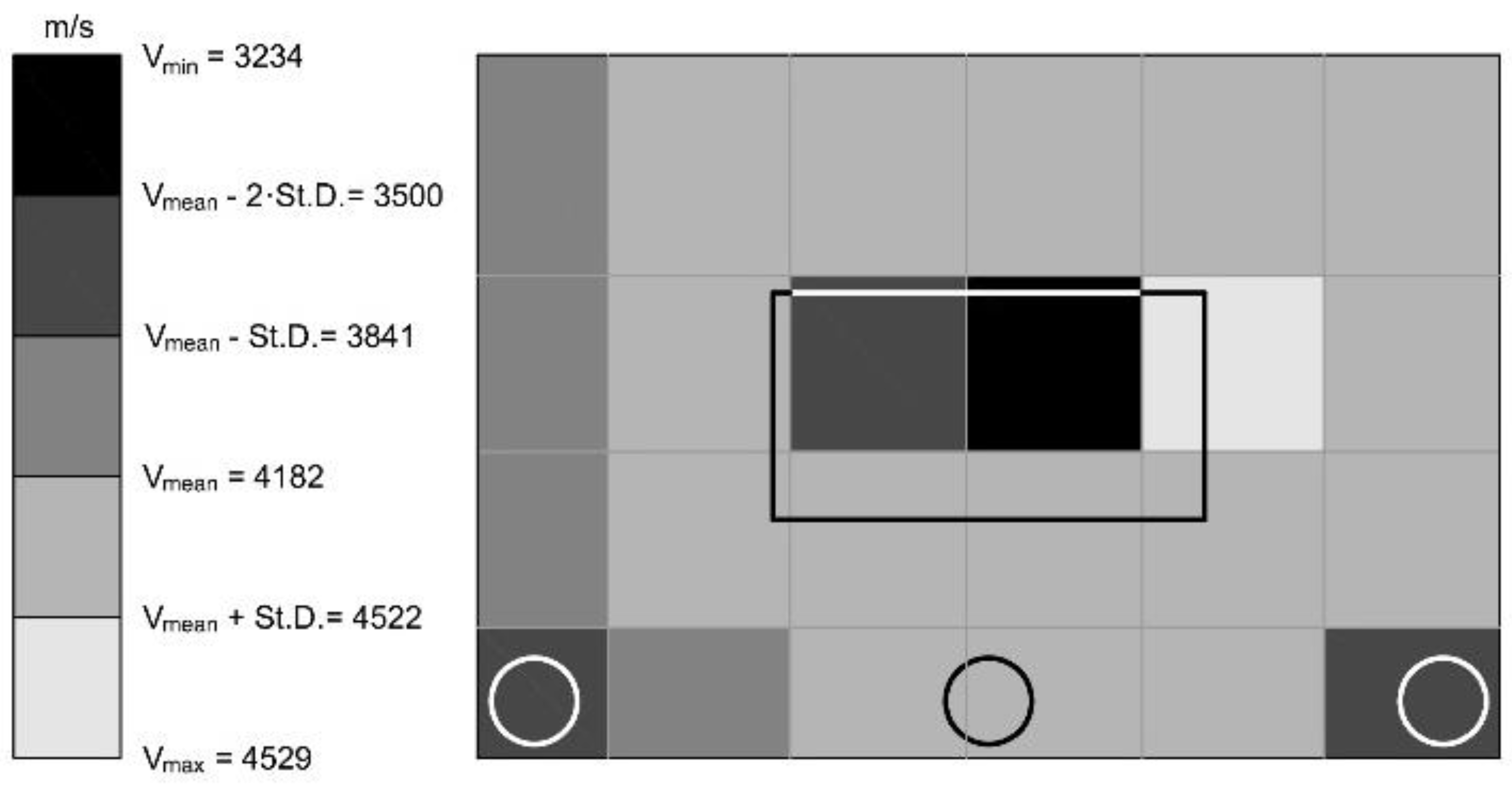

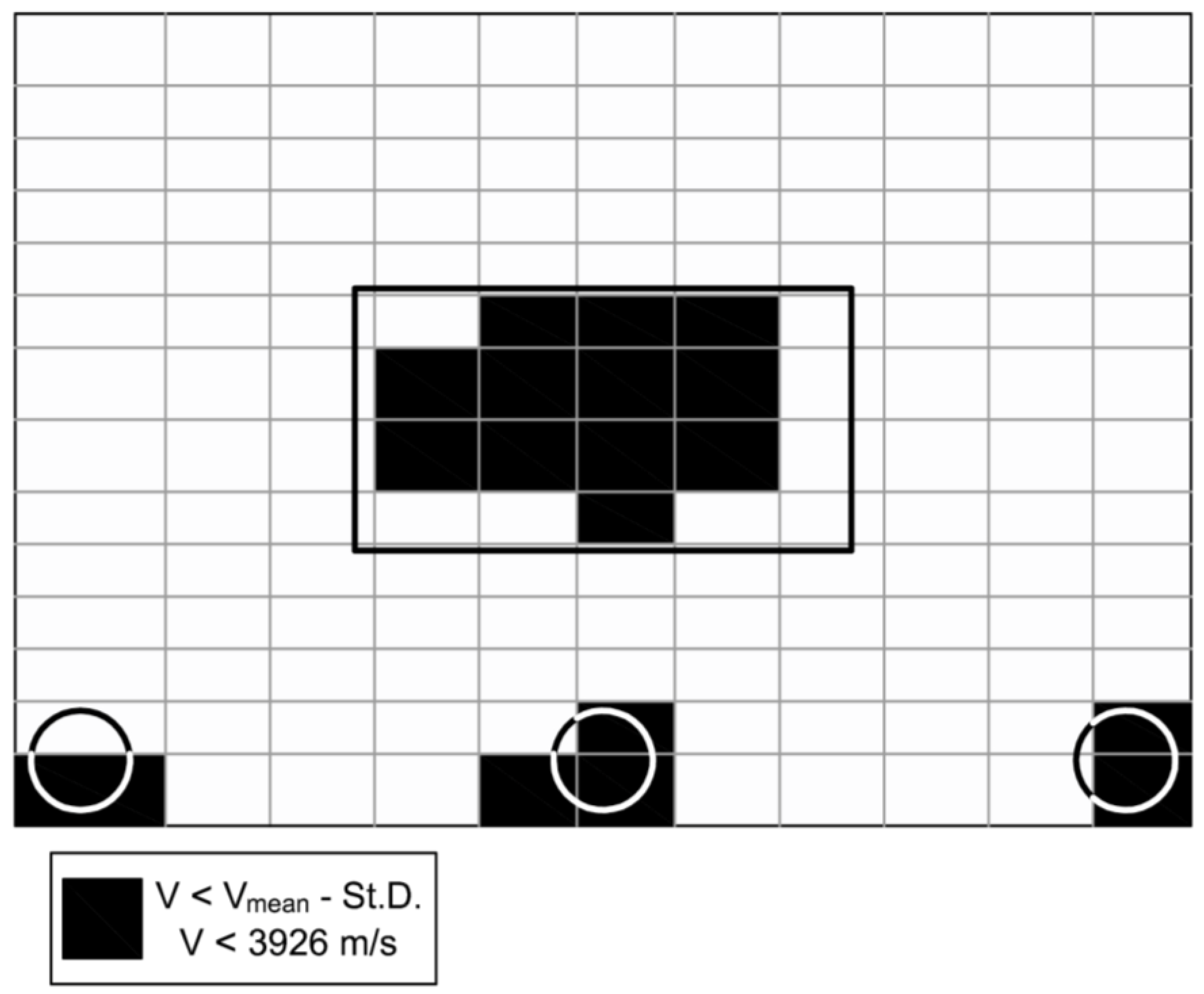
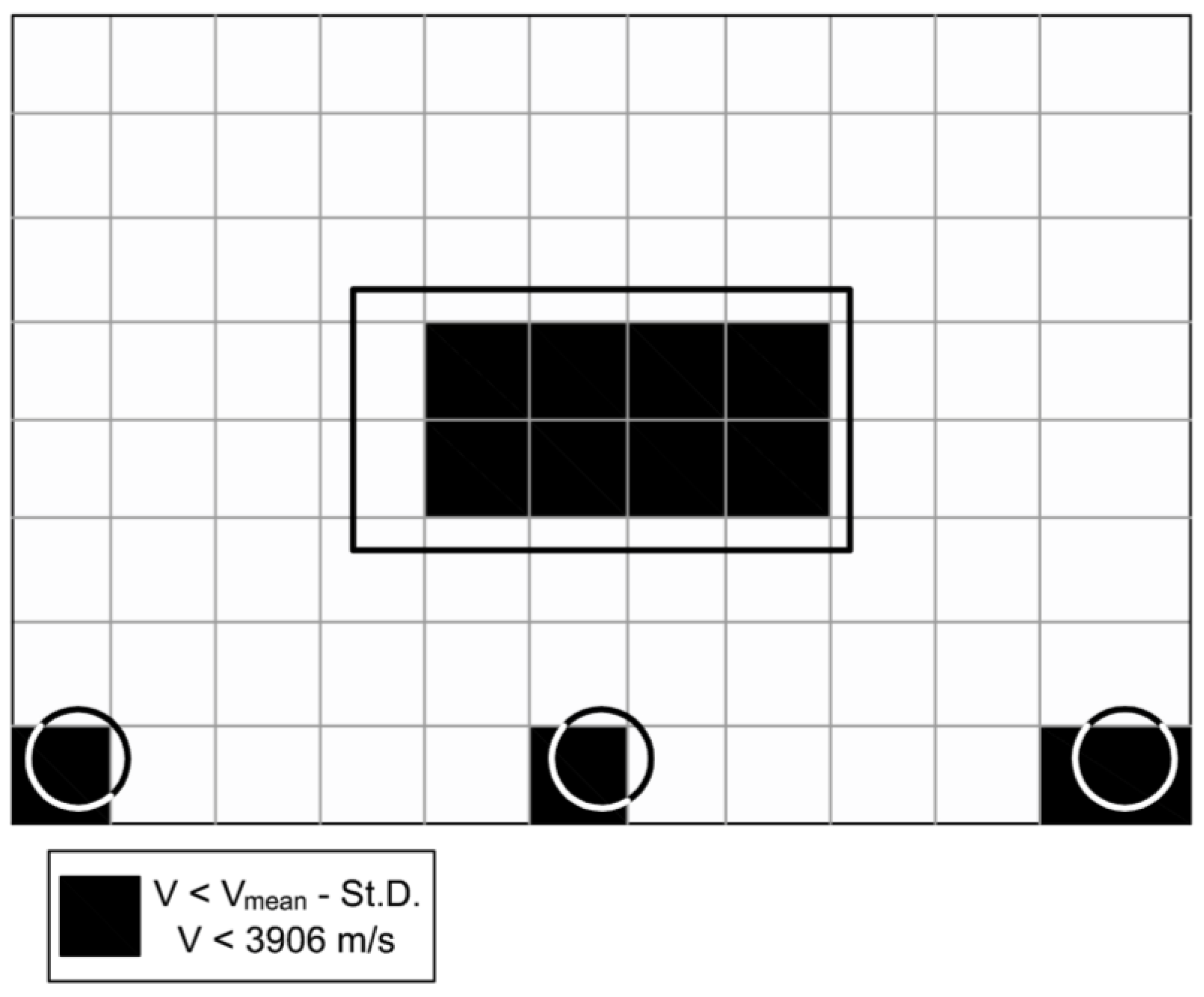

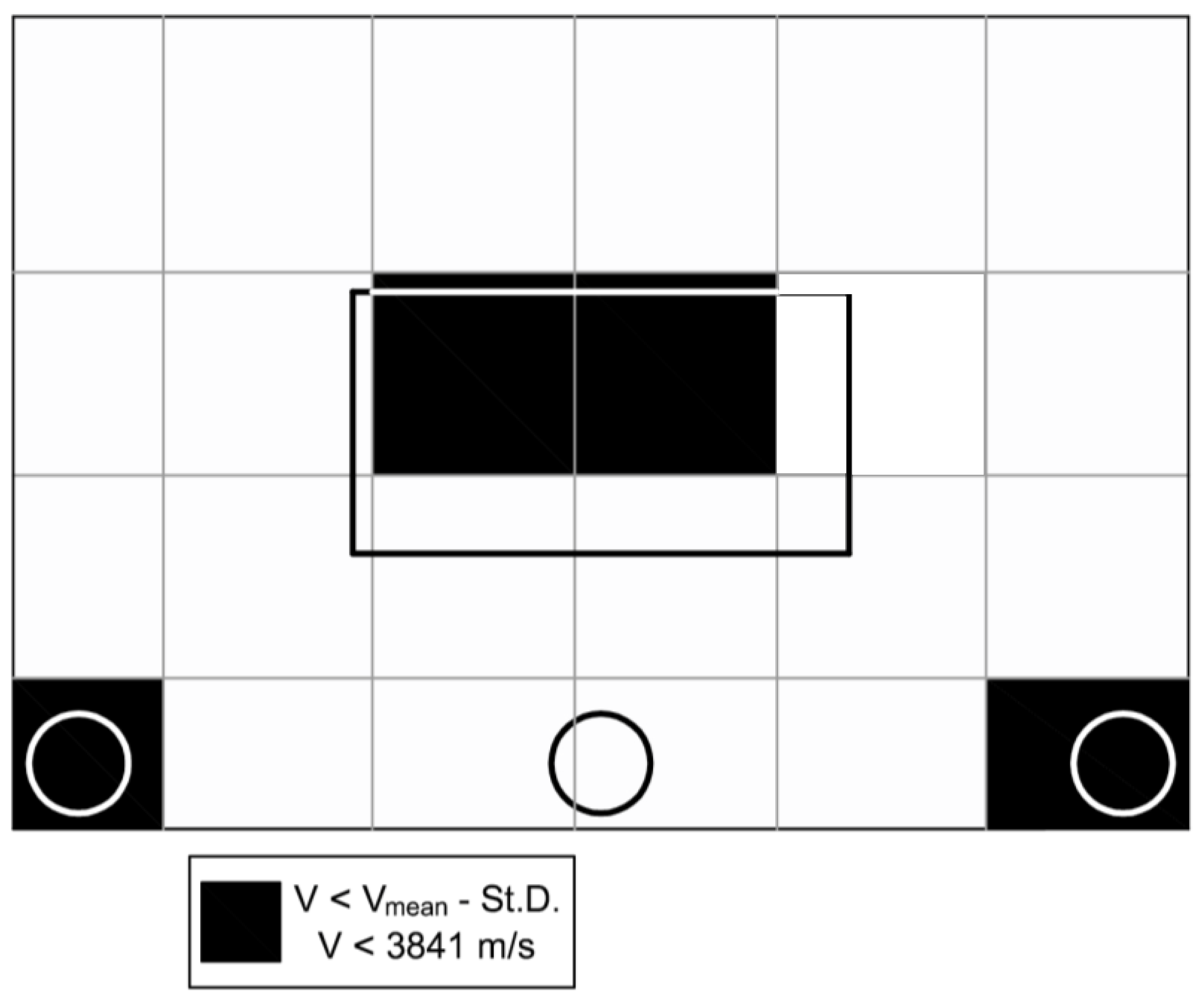
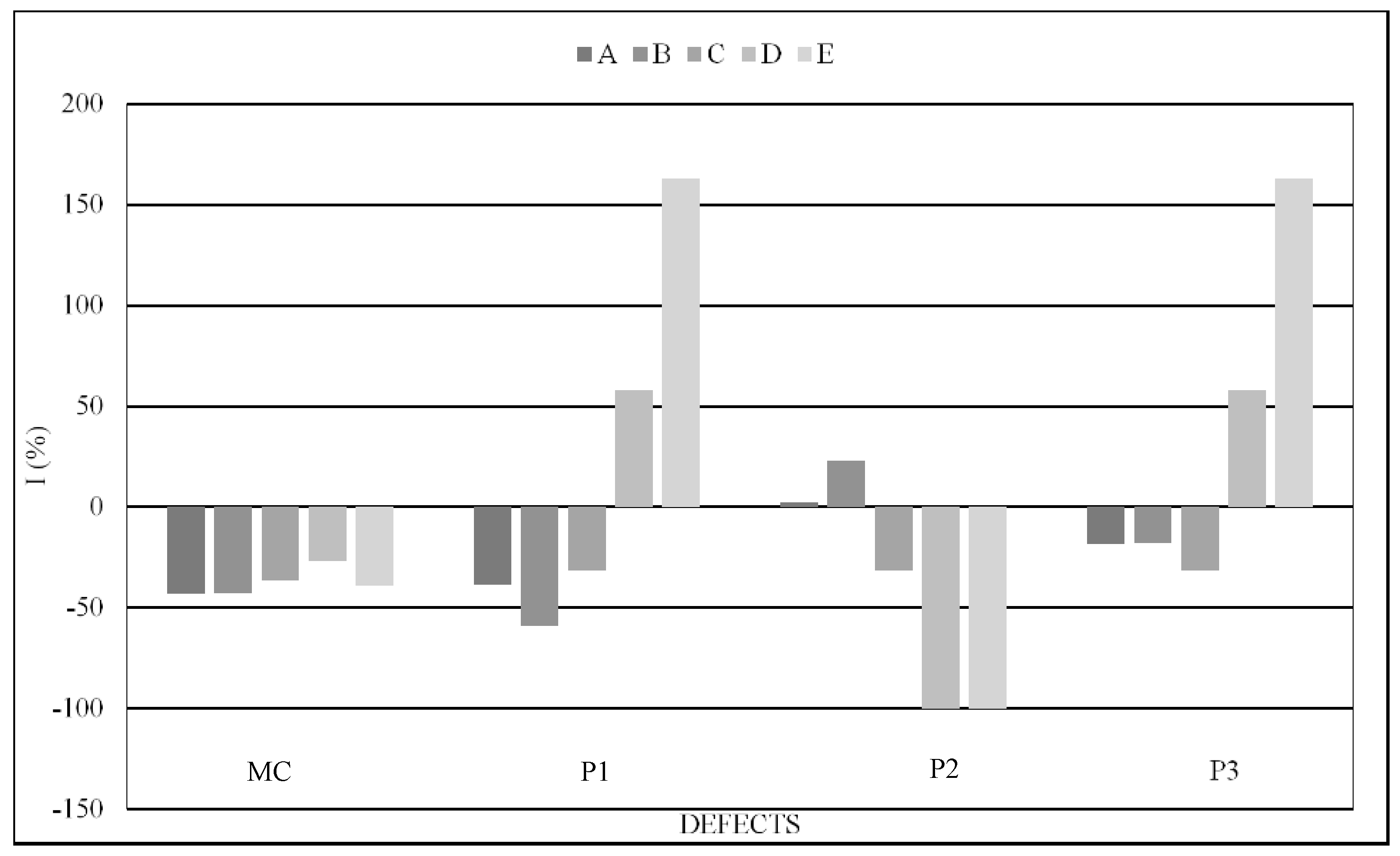
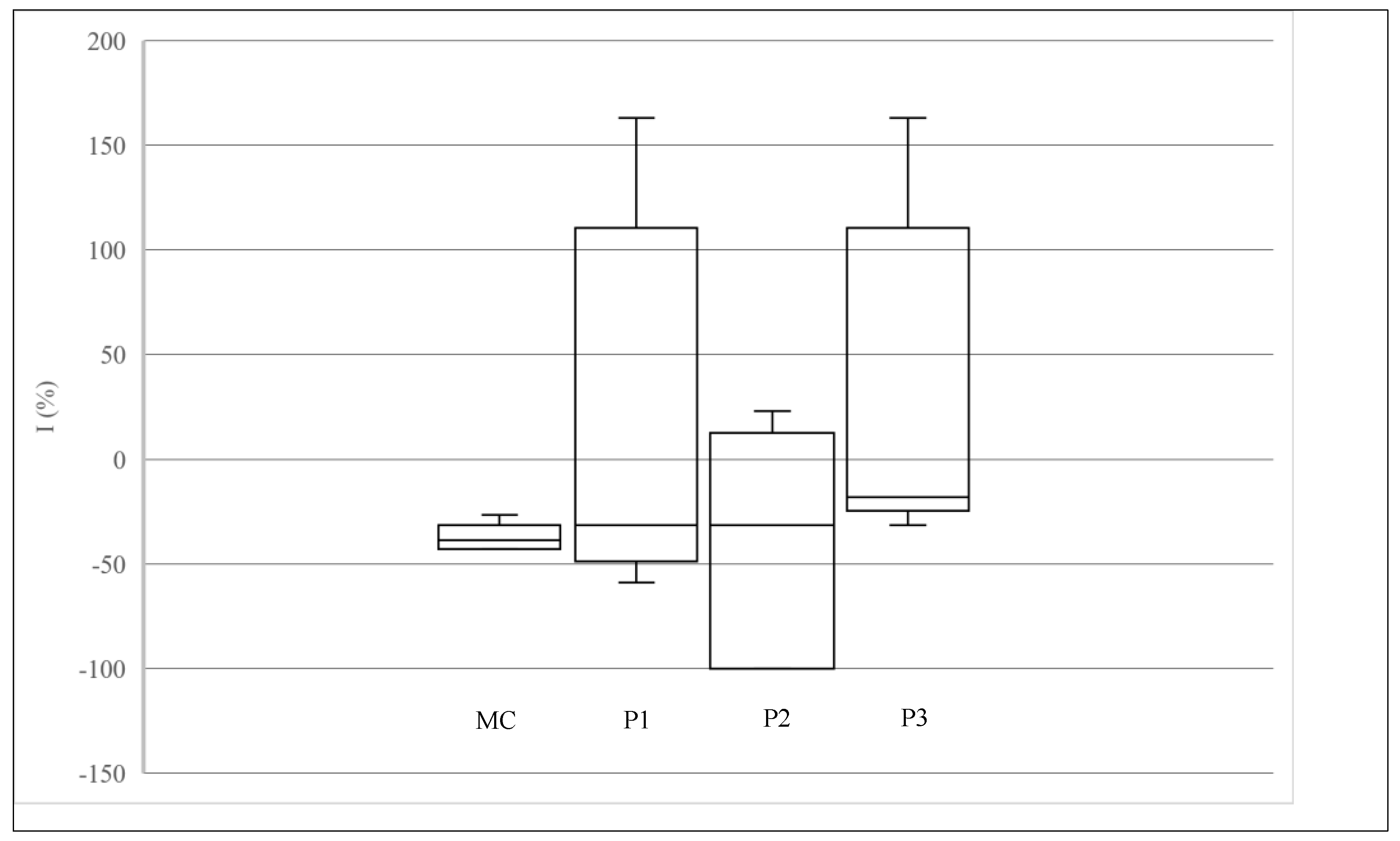
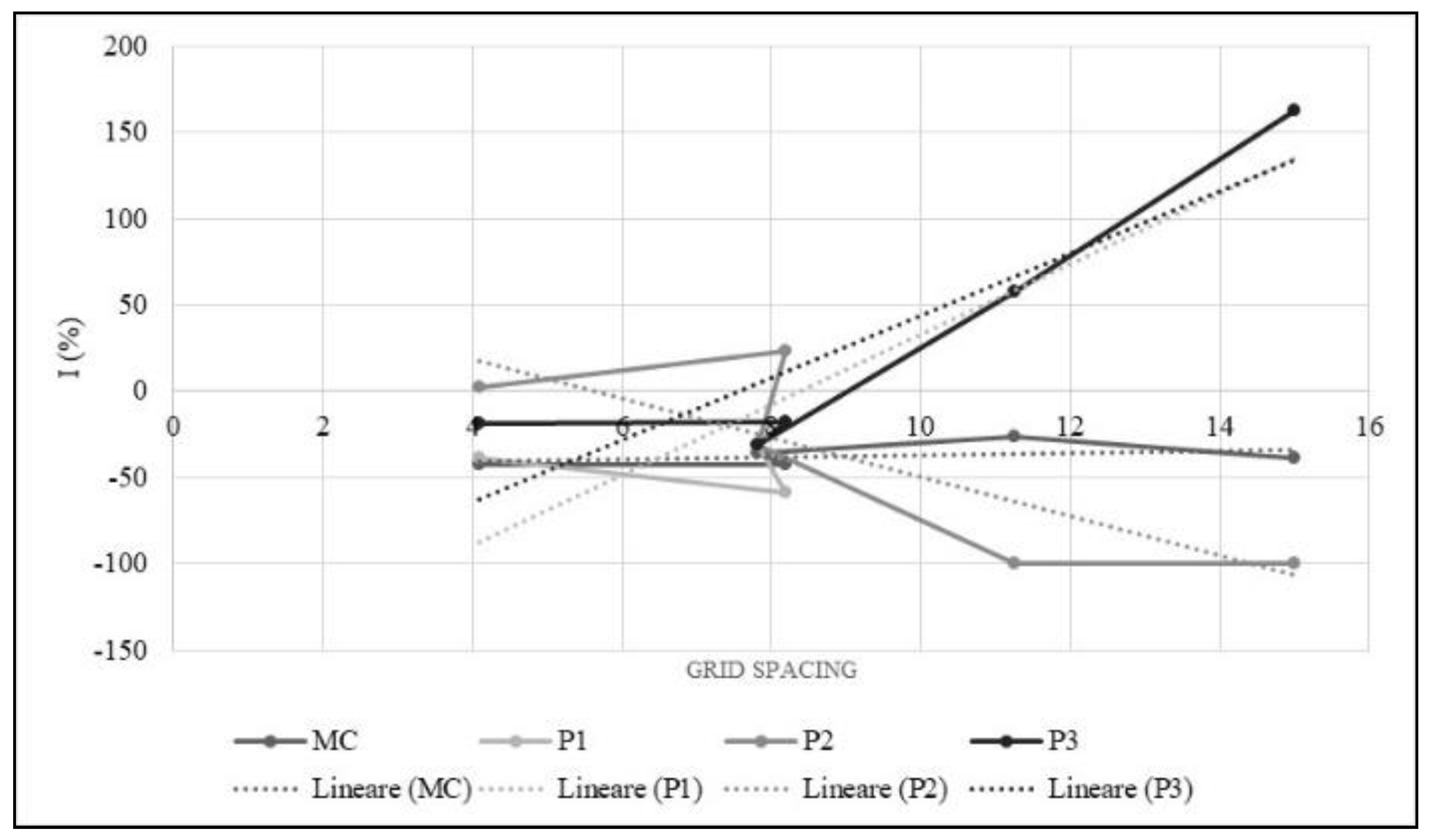

| Grid | Number of Cells | X × 10−2 (m) | Y × 10−2 (m) |
|---|---|---|---|
| A | 308 | 4.08 | 4.43 |
| B | 154 | 8.18 | 4.43 |
| C | 88 | 7.82 | 7.75 |
| D | 40 | 11.25 | 12.40 |
| E | 24 | 15.00 | 15.50 |
| Grid | Vmin (m/s) | Vmax (m/s) | Vmean (m/s) | St.D. 1 (m/s) | CoV 2 (%) |
|---|---|---|---|---|---|
| A | 2874 | 4540 | 4239 | 299.79 | 7.07 |
| B | 2874 | 4540 | 4240 | 313.44 | 7.39 |
| C | 3094 | 4529 | 4222 | 315.75 | 7.48 |
| D | 2874 | 4529 | 4165 | 367.92 | 8.83 |
| E | 3234 | 4529 | 4182 | 340.89 | 8.15 |
| Average | 2990 | 4533 | 4210 | - | - |
| St.D. | 166.37 | 6.02 | 34.25 | - | - |
| Defect | Grid | Aact × 10−4 [m2] | Aest × 10−4 [m2] | I [%] |
|---|---|---|---|---|
| MC | A | 760.00 | 433.79 | −42.9 |
| B | 434.85 | −42.8 | ||
| C | 484.84 | −36.2 | ||
| D | 558.00 | −26.6 | ||
| E | 465.00 | −38.8 | ||
| P1 | A | 88.36 | 54.22 | −38.6 |
| B | 36.24 | −59.0 | ||
| C | 60.61 | −31.4 | ||
| D | 139.50 | 57.9 | ||
| E | 232.50 | 163.1 | ||
| P2 | A | 88.36 | 90.37 | 2.3 |
| B | 108.71 | 23.0 | ||
| C | 60.61 | −31.4 | ||
| D | 0.00 | −100.0 | ||
| E | 0.00 | −100.0 | ||
| P3 | A | 88.36 | 72.30 | −18.2 |
| B | 72.47 | −18.0 | ||
| C | 60.61 | −31.4 | ||
| D | 139.50 | 57.9 | ||
| E | 232.50 | 163.1 |
© 2018 by the authors. Licensee MDPI, Basel, Switzerland. This article is an open access article distributed under the terms and conditions of the Creative Commons Attribution (CC BY) license (http://creativecommons.org/licenses/by/4.0/).
Share and Cite
Concu, G.; Trulli, N. Concrete Defects Sizing by Means of Ultrasonic Velocity Maps. Buildings 2018, 8, 176. https://doi.org/10.3390/buildings8120176
Concu G, Trulli N. Concrete Defects Sizing by Means of Ultrasonic Velocity Maps. Buildings. 2018; 8(12):176. https://doi.org/10.3390/buildings8120176
Chicago/Turabian StyleConcu, Giovanna, and Nicoletta Trulli. 2018. "Concrete Defects Sizing by Means of Ultrasonic Velocity Maps" Buildings 8, no. 12: 176. https://doi.org/10.3390/buildings8120176
APA StyleConcu, G., & Trulli, N. (2018). Concrete Defects Sizing by Means of Ultrasonic Velocity Maps. Buildings, 8(12), 176. https://doi.org/10.3390/buildings8120176




